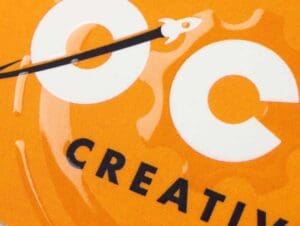
Without any other information, your potential customers will assume better businesses have better business cards. Chances are you don't give business cards much thought, but you should. Let's start with a story. About five years ago, we met a newly minted physical therapist. At the time, he was fresh out of physical therapy school and ready to blaze a path helping people get back into daily living. He had (still has) all the skill and personality to make a big difference for a lot of people, but first they would need to know he existed, let alone available to see patients. He chose to work independently through an office that housed several physical therapists, each competing for whatever patients would walk in. In order to avoid bias, the receptionist would direct visitors to a grouping of a dozen or so, you guessed it, business cards. We've been advocates of great business card design for decades, but this one physical therapist's experience sums up how important business card design really is. Right out of school, budget was a major concern, but we convinced him even expensive business cards are cheap--especially if it's your only form of marketing. In the end, I think 1,000 cards cost him maybe $150, plus a little bit of design time. Altogether, he probably paid about a quarter a card for that first order. That's quite a bit when you consider some places will sell you a thousand business cards for $25. That cost difference translates to a lot of ramen noodles, which is an important consideration at the early stage of any career.
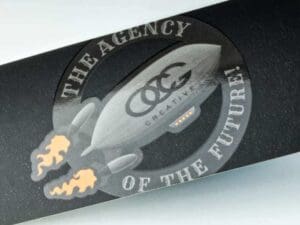
Before I skip to the end of the story, let me introduce you to the concept of opportunity cost. Opportunity cost is the future pain you inflict on yourself, measured in dollars, for being unable or unwilling to make a good decision today. In this case, the good decision was to invest an extra $125 in business cards that made him look awesome compared to the competing therapists. From the very first day, he crushed them. Literally, all of the patients that walked in the door chose him over the others. Today, he has his own thriving practice, to which, he gives significant credit to the early boost he got by dominating his competitors with business cards. The opportunity cost would be to exchange all of that for $125 he'd have blown on noodles.
For starters, going low-tech shouldn't be lame. Your business card should feel like a gift. Don't laugh. Your card can be that cool. Let's break it down.
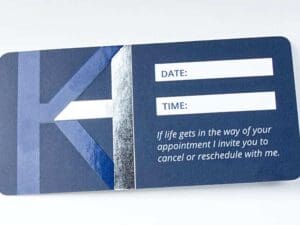
Graphic design for business cards is, in some ways, secondary to other elements like paper selection and coatings. However, aside from pure gold, no coating will ever make up a bad design. The moral here is to have a pro design your card. Even if you spend a few hundred bucks, you'll only spend it once, and a good designer will make you look like you are a market leader. Color and typography must be perfect. Graphics must be unique and tack sharp, and your logo... ...your logo has to be (a) a logo, and (b) support your brand. In a future post, I'll detail all the ways business owners sabotage their brand with crappy logos, but that's a topic for another day. Let's assume your logo is perfect.
As I mentioned earlier, even expensive business cards are cheap. Not coincidentally, OCG Creative is leading marketing agency for the scuba diving industry. Same for musical instruments and adventure travel. We target these because we have direct history and personal expertise, which gives us a huge advantage over agencies that need to learn from scratch.
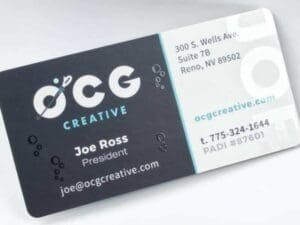
The boost in visibility that provides to our clients in those industries is a really big deal. In order to underscore that, we have designed specialized business cards specific to each industry. Pictured is the card I use when working with scuba resorts, diving equipment manufacturers and retailers. We exhibit at a diving industry trade show (DEMA Show) every year. Having my PADI instructor number printed on the card provides credibility, while the specialized branding helps identify us as the obvious choice for scuba-related businesses seeking a marketing agency. If your business targets a specific industry, this specialized approach can be very powerful--especially if you belong to trade organizations or offer additional expertise.
Business cards don't have to be made of heavy paper, but they probably should. While a card can be fashioned from metal, plastic, leather, bamboo or even chocolate, these materials can be difficult to handle in some business settings. These can also run a few dollars a card and be challenging to re-order. So, while I've seen some incredibly cool cards made from surprising materials, these can be impractical and unnecessarily expensive. There are many different papers available for business cards. In general, heavier cards have a richer feel, and standard, smooth papers provide the most options for ink choices and special coatings.
Matte Dull offers a clean, modern look and is glare-free. This style works great with subdued designs and color palettes and will often look cleaner as fingerprints won't show. It is also a great choice if you plan to write on your business cards.
Not only do glossy business cards look great, but they are longlasting and durable. Cards with a glossy finish stand out and have a longer lifetime. A gloss can also help preserve bright colors and photos included on your cards.
Spot UV adds selective glossiness over targeted portions of your card. This style can be added to logos, text, graphics or images to add contrast or highlights. Against a matte background, your logo will stand out with Spot UV.
Silk is a beautiful finish that has a tactile feel and presence you have to see and touch to believe. A laminate coating is placed over the top of each business card for an elegant and modern appearance. Silk business cards are water resistant, highly durable and great for accenting bright pops of color. You can also write on these business cards.
Silk with Spot UV is the ultimate way to leave a long lasting impression. Spot UV will accent your silk finish, accentuating your logo or any other element of your card. For a distinguished flare, this style will bring your business cards to the next level of professionalism.
Rounded corners can be applied to any printing and coating options. Smoothed out corners add a subtle, but impressive touch. Other unconventional designs, such as odd-shaped cards or squared cards can also give your business a unique look.
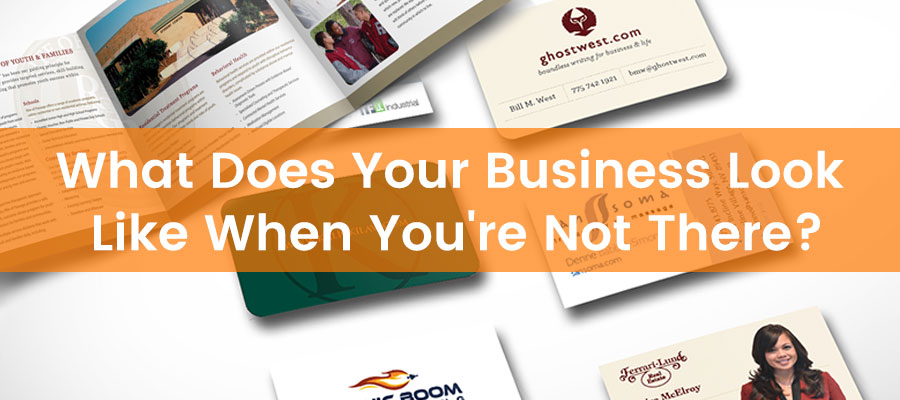 You did it! You finally opened that business you’ve been talking about for years. Now what? It’s the perfect time to make a great first impression. Often times businesses overlook the importance of the little things--business cards, flyers, brochures, posters, signs and the impact print marketing materials can have on the business. Think of what a great impression you make in person when sharing your excitement about your business. Now think about what your business looks like when you’re not there to represent it. Do your business cards leave a lasting impression like your meetings do? Does the post card you send out or the flyer you hand out look as professional and hip as your company really is? Taking time to create print collateral that represents your company image is as important as paying the electric bill. If your potential clients aren’t attracted to your print marketing pieces, then you’ve missed the mark.
You did it! You finally opened that business you’ve been talking about for years. Now what? It’s the perfect time to make a great first impression. Often times businesses overlook the importance of the little things--business cards, flyers, brochures, posters, signs and the impact print marketing materials can have on the business. Think of what a great impression you make in person when sharing your excitement about your business. Now think about what your business looks like when you’re not there to represent it. Do your business cards leave a lasting impression like your meetings do? Does the post card you send out or the flyer you hand out look as professional and hip as your company really is? Taking time to create print collateral that represents your company image is as important as paying the electric bill. If your potential clients aren’t attracted to your print marketing pieces, then you’ve missed the mark.
Print them in bulk and hand them out like candy. If you’re making excuses for your business cards, it’s time to rethink your approach. Add spot UV to a silk finish for a great looking, great feeling card.
Pick an uncommon size. If it looks like all the rest, it will get lumped with all the rest. Stand out! Try a square brochure or one with rounded corners.
Print on both sides and make sure to use lots of stunning photos and color. Black letters on neon yellow paper should be used for yard sales and school projects.
Having a retractable banner is handy to set up at trade shows, networking events and impromptu sponsorship opportunities. Create a visually spectacular banner with company info and be ready to dazzle any crowd. Hanging banners can be powerful as well and come in a variety of sizes: from small table banners to building banners that are temporary signs. Regardless of the size, make sure the presentation and message are well thought out.
Mail boxes get bombarded with junk mail. Make sure your mailer looks a cut above the rest and doesn’t get hidden behind all of the #10 envelopes. Find a size that stands out in the clutter and focus on eye-catching graphics and simple, powerful messaging.
The best signs are the ones that can be seen and read from long distances. Don’t clutter a sign with unnecessary info or graphics. Choose colors and lettering that that are easy to read any time of day. Your print collateral serves as your marketing, your lead generation tool, and represents your company brand. It also paves the way for your future efforts: website, social media, email marketing and internet marketing. So, take the time and effort to make sure that all of your collateral represents your business in the way you would in person. Are you a new business? OCG Creative can print all of your business collateral with a fast turn around. If it has a surface, we can brand it! We have curated many print marketing materials for a multitude of clients both locally and nationally. Contact us to learn more.
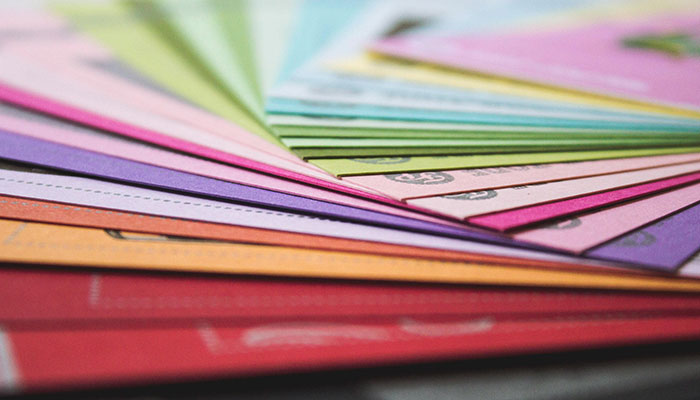
With over 15 years of print experience, Charles Driver, Print Manager of OCG Creative, weighs in on the importance of having quality print marketing materials that represent your brand in a professional light. I have to admit that I’m a bit of a printing snob. Whenever I visit a local place in Reno, the first thing I do is take a look at the print marketing pieces they have lying around. Whether it’s business cards, brochures, or menus—a few things instantly pop into my mind. I can usually tell a company’s marketing budget and how much importance they put on their branding just by looking at their print collateral.
First off, does the piece look like it was created in a bootlegged copy of some office writing program? It’s very easy to tell when a talented designer had a hand in a particular design. You may not even realize it, but behind the scenes, your brain is making assumptions about the design. Subconscious lines are being drawn and everything is measured against a Fibonacci sequence. Go ahead, give yourself credit, you know good design when you see it. It’s colorful, vibrant and draws your eye in just the right path across the surface of the material. A poor design, on the other hand, consists of a basic border around the page, a begrudging splash of color, and generic fonts—looking at you Times New Roman. Poor aesthetic sends a clear message: we spent no time designing this piece. How is this going to represent your business? At the end of the day, it pays to invest in a good graphic designer.
Let’s be honest, glossy paper has been out of fashion for a long time. Just like a car immediately depreciates in value when you drive it off the lot, so does any marketing piece printed on gloss. It loses its luster as soon you pick it up from the printer. Fingerprints and high glare are unattractive in the hands of your target audience. Choosing a matte dull paper type is classy, looks good in all lighting conditions, and leaves room for accents. Want to add a kick? Go heavy, everyone has basic printer paper laying around somewhere but there are other tiers to consider between basic and card stock. Handing out flyers? Try something in a 28lb. Giving out menus? 80lb book makes the presentation a tactile feast and prevents images from bleeding through on the other side.
A trend that is not entirely new, but certainly gaining more traction is using a spot UV coating to highlight certain elements of a printed piece. Spot UV simply means selective gloss coating, and a good designer will offer plenty of unique ways to use it. After discovering this option in printing a few years ago, I’m now seeing this subtle, yet enticing accent in everything I purchase, from merchandise boxes to book covers. While I do see Spot UV enjoying its time in the sun for many more years to come, if you want to get ahead of the curve try a satin or silk coating. If paper type can be considered a tactile feast, then you’ve just been invited to a fancy dinner with steak and lobster when you use satin or silk. While they’re still considered a matte finish, these two coatings have a striking visual quality that is matched only by how they feel in your hands. These pieces demand to be taken home. In the end, design is the first and possibly the most important step in your printing journey. What your piece says about you right now decides whether it gets tossed in the bin or hung on the fridge. Designing your piece for print should be a collaborative and engaging process. The design itself should speak to the overall purpose of that piece. If I’m wandering through your establishment, I’m certainly looking and making judgements about your brand.
Learn more about the printing services that OCG Creative can offer,